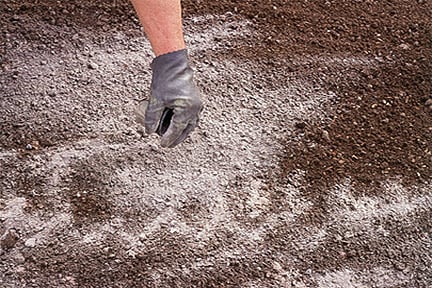
Quick facts
Suitable for: All garden soils, but not potting media, fertilisers or manures
Timing - Winter, or before planting
Difficulty - Easy
When to lime
Lime is usually added in winter for annual crops, such as vegetables, just prior to digging, as the lime can take effect over the winter months and will not damage young growth.
Before planting plants like lawns, shrubs, fruit or trees, apply lime if the soil is acid. To find out how much lime is required you need to check your soil pH.
Lime applied to the surface, around for example, can take years to have any effect, so adjusting before planting or sowing is recommended.
A soil pH test measures the acidity or alkalinity of the soil. A pH 7.0 is considered neutral. Above pH 7.0, the soil is alkaline and below pH 7.0, the soil is acid. See our page on soil pH testing for more detail.
It is especially worth checking soil pH and making any adjustments before designing or planting a new garden, making vegetable plots, planting fruit or when growth is disappointing.
Testing can be done at any time, but if carried out within three months after adding lime, fertiliser or organic matter, the test may give misleading results.
If your soil pH test comes back at 7.0 or higher, you have alkaline soil, and liming is not necessary. If the pH is above 6.5, or if you wish to grow acid-loving ericaceous plants, you may wish to reduce the pH by adding an acidifying material.
What to use
Liming materials
Lime raises and is usually added as ground limestone, commonly called ‘garden lime’. The active ingredient is calcium carbonate. Ground limestone is easy to spread, widely offered in garden centres, and is the recommended liming material for gardeners. Calcified seaweed and ground chalk are other forms of calcium carbonate offered to gardeners.
Ground magnesian limestone, often called ‘Dolomite lime’ is a ground limestone rich is magnesium carbonate as well as calcium carbonate and is used to lime soils that lack magnesium (see our page on plant nutrition for more information on plant nutrients).
Hydrated lime (calcium hydroxide), sold for use by builders, can also be used. It is a fine powder, quick acting, but can irritate skin and eyes if not handled carefully.
The effectiveness (called the ‘Neutralising Value’ (NV)) is expressed as a percentage of the neutralising value of pure calcium oxide (which is caustic so cannot be used). The NV varies between materials – typical examples include:
- Ground Limestone (garden lime) – NV 50-55
- Ground Chalk – NV 50-55
- Ground Magnesian Limestone (Dolodust) – NV 56
- Calcified Seaweed – NV 44
- Hydrated Lime – NV 70
Therefore, if you use hydrated lime, you will need much less than products containing calcium carbonate.
Liming materials are very finely ground so that they work quickly. Avoid any products with lumps, as they will take years to have any effect.
How to lime
Method of application
When applying more than 0.5kg per sq m (14¾oz per sq yd), it is best to dig half into the soil and sprinkle the rest on the surface after digging.
When applying less than 0.5kg per sq m (14¾oz per sq yd), dig the entire amount in, but you can sprinkle it on the surface if digging is not practical.
Quantities to apply
The clay in soils resists changes in (called buffering capacity) so that much more lime is needed to change the pH in soils with high clay content than in soils with little clay, such as coarse sandy soil. See our page on soil types for more information on assessing your garden soil type.
The recommendations below are for the finely ground garden lime (calcium carbonate) sold in garden centres in kilograms (kg) per square metre or ounces per square yard. They are based on the Department for Environment, Food and Rural Affairs (DEFRA) recommendations for incorporation into the top 20cm (8in) of soil and are enough to raise the soil pH to pH6.5. This is considered the best all-round pH for the majority of garden plants.
Clay soil – Original soil pH
- 6.0 – 0.6 Kg per m2 (17¾ Ounces per sq yard)
- 5.5 – 1 Kg per m2 (29½ Ounces per sq yard)
- 5.0 – 1.4 Kg per m2 (41¼ Ounces per sq yard)
- 4.5 – 1.8 Kg per m2 (53 Ounces per sq yard)
Loam soil – Original pH
- 6.0 – 0.5 Kg per m2 (14¾ Ounces per sq yard)
- 5.5 – 0.8 Kg per m2 (23½ Ounces per sq yard)
- 5.0 – 1.2 Kg per m2 (35¼ Ounces per sq yard)
- 4.5 – 1.5 Kg per m2 (44¼ Ounces per sq yard)
Sandy soil – Original pH
- 6.0 – 0.4 Kg per m2 (11¾ Ounces per sq yard)
- 5.5 – 0.7 Kg per m2 (20½ Ounces per sq yard)
- 5.0 – 1.0 Kg per m2 (29½ Ounces per sq yard)
- 4.5 – 1.3 Kg per m2 (38¼ Ounces per sq yard)
Problems
Take care if using builders’ lime (hydrated lime), as it can be irritating to the skin and eyes. Wear gloves and consider safety goggles if adversely affected.
Some plant diseases, such as clubroot of brassicas, are associated with insufficient lime levels in the soil.
Some plant nutrient deficiencies can be associated with acid or conditions.


